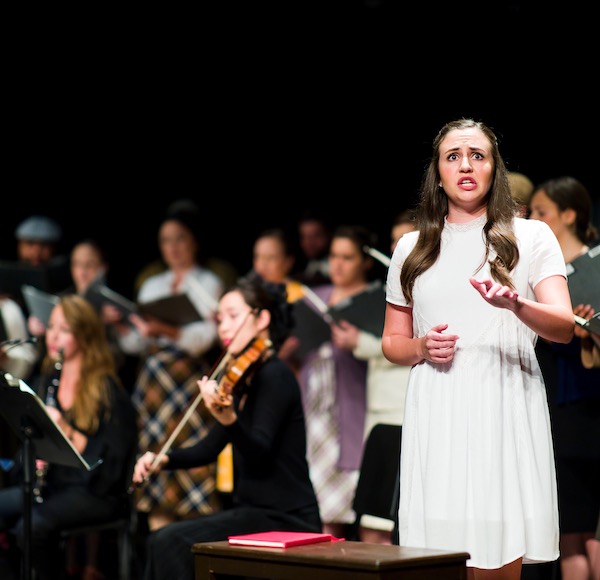Anne Frank cantata opens Houston Chamber Choir season on a somber note

James Whitbourn’s cantata Annelies grows from powerful material: the diary of Holocaust victim Anne Frank, whose full name was Annelies Marie Frank.
Thanks to its poignant and still-relevant story, the 70-minute work led two Houston cultural groups to join forces. The Houston Chamber Choir opened its season with Annelies, and Holocaust Museum Houston hosted the performances in the center’s new Herzstein Theater, a 200-seat venue that opened this summer.
Premiered in England in 2005, Annelies’ music may not equal the emotional impact of Frank’s words, but the score contains telling passages, and the choir’s polish and conviction drove them home Sunday afternoon.
Whitbourn, a Briton with extensive experience as a composer and producer for the BBC, crafted the cantata alongside British author Melanie Challenger, who translated the diary excerpts that make up most of the libretto. In an introductory talk from the stage Sunday, Whitbourn said the pair won permission to quote Frank’s words thanks to a cousin of hers they invited to a showcase of the work-in-progress.
The completed work interweaves Frank’s description of her family’s unfolding saga–from their planning to hide from the Nazis through their life in seclusion, capture and imprisonment–with her meditations on the world around her. “Beauty remains, even in misfortune,” she reflects at one point. “One who is happy will make others happy, one who has courage will never die in misery.”
For the diary’s most personal reflections, Annelies casts a soprano soloist as Anne herself. While Whitbourn’s original scoring marshals an orchestra, his own scaled-down version–employed Sunday–condenses the forces down to violin, clarinet, cello and piano.
In keeping with the directness of Frank’s words, Annelies’ music gravitates towards simple lyricism. While that often has a pensive, melancholy cast, brightness sometimes breaks through: When Frank imagines the sunshine bathing chestnut trees and seagulls, a gentle waltz tune helps her thoughts take flight.
The spare, stark music that evokes the secrecy in the family’s hiding place and the fear that sometimes grips them is especially haunting. Sometimes the score gains impact by doing the opposite of what’s obvious: As the city is being bombed, the choir describes the conflagration in still, calm phrases–then explodes as it conjures up the fear gripping Frank.
Sometimes the score works less well. A march melody that’s obviously meant to evoke resoluteness is a little too catchy; if the words were removed, it could pass for an Astor Piazzolla tango. When Frank describes daily life in the hiding place, the hale-and-hearty music harkens back to the World War I hit “It’s a Long Way to Tipperary.” Whitbourn must have had a reason for linking that to a teenager in World War II Holland, but it’s hardly evident from listening.
Conductor Robert Simpson and the choir gave Annelies a theatrical tinge. Wearing street clothes that could have come from decades ago–and maybe did–the choir evoked a 1940s populace. Soprano Laura Broscow, portraying Frank, sat at a writing table with pen and diary, rising when it was time to sing.
But the work’s drama was strongly conveyed through the singing. The choir’s poise and expressiveness revealed the emotion in Whitbourn’s lyricism. When the music described secrecy and wariness, the group’s hushed tone put across the tension.
The choir’s sweet, gentle vocalism let it savor the Schubertian euphony of a prayer in German–Frank’s parents’ native language.
Though soprano Broscow is a young adult, her voice’s brightness helped suggest a teenager’s youth and spirit. She sang with a fervor that captured Frank’s before-her-time emotional maturity.
The instrumental group–violinist Ling Ling Huang, clarinetist Rebecca Tobin, cellist Steve Estes and pianist Andreea Muţ–enhanced the score’s atmosphere, especially in moments of mystery or stillness. Huang played at times with a fullness and ardor that practically turned the violin into Frank’s alter ego.
The Holocaust Center’s new theater served the performers well. No mere lecture hall, the venue offered a thrust stage with more than enough room for a choir of 25 and the instrumental group.
The seating, rising amphitheater-style, offered the audience clear views of the stage. And while the acoustic obviously doesn’t offer cathedral-style glow, the singing and playing came across crisply and clearly. The theater could offer other chamber-sized music groups a congenial showcase.
The Houston Chamber Choir will perform “By Local,” a program featuring music by Houston-area composers, at 7:30 p.m. Nov. 16 at South Main Baptist Church. houstonchamberchoir.org; 713-224-5566


